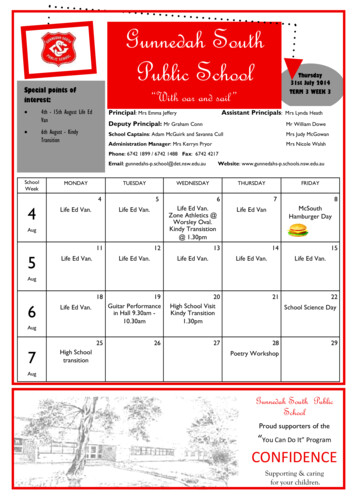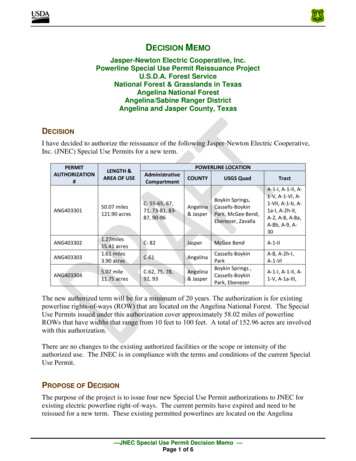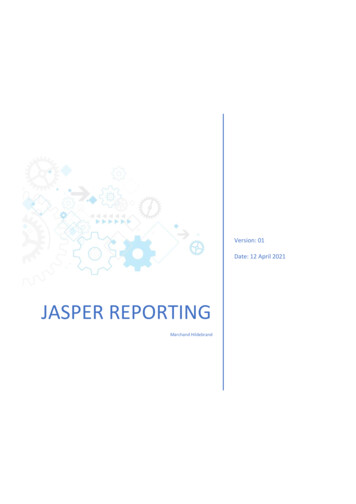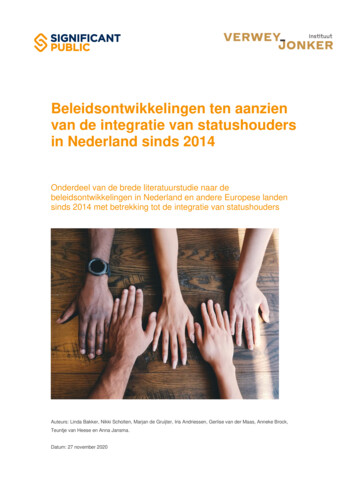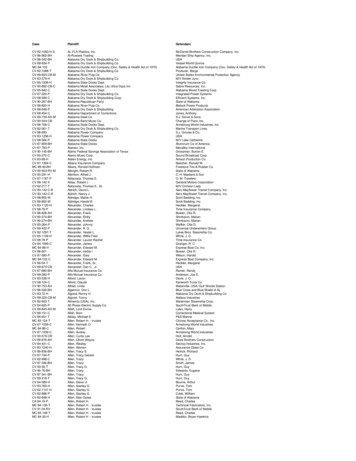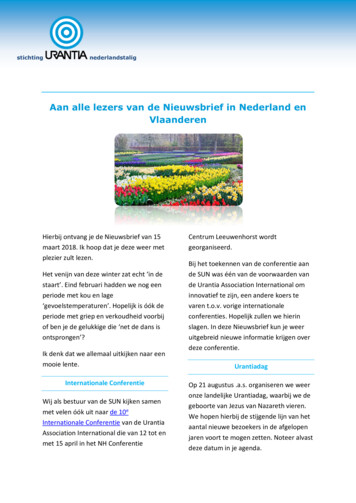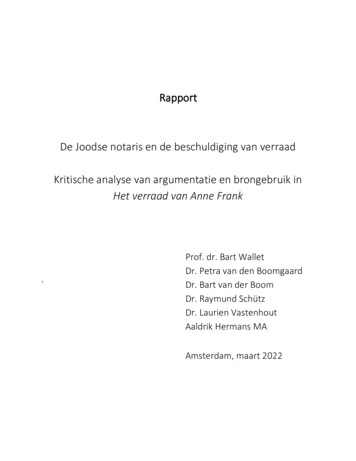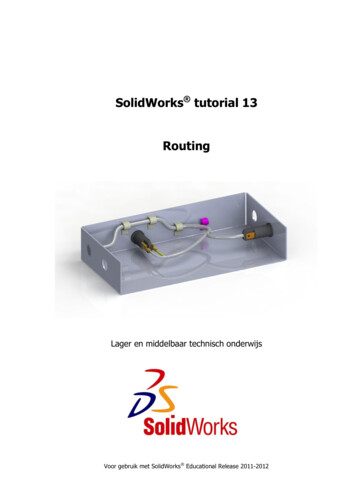
Transcription
Professor Jasper HalekasVan Allen Lecture Room 1MWF 8:30-9:20 Lecture
¡No Labs or Discussions Week One!§ Labs and Discussions will both start next week
¡Today: Syllabus Day!¡Wednesday: Math Review¡Friday: Displacement/Velocity/Acceleration
This Course
are featuredin several physiologically important processes, including the circulation of blContent Category 4A: Translational motion, forces, work, energy, and Fluidsequilibriumin livingmovement into and out of the lungs, and gas exchange with the blood. The energetic requiremensystemsContent Category 4B: Importance of fluids for the circulation of blood, gas movement, adynamics can be modeled using physical equations. A thorough understanding of fluids isThe motion of any object can be described in terms of displacement, velocity, fluidandgasacceleration.exchange Objectsnecessaryunderstandaccelerate when subjected to external forces and are at equilibrium when the netforce andtothenet torquethe origins of numerous forms of disease.Fluidsarefeaturedin severalphysiologically important processes, including the circulation of blooacting upon them are zero. Many aspects of motion can be calculated with the knowledge that energyisThecontentinthiscategorycovershydrostatic pressure, fluid flow rates, viscosity, the Kineticmovementinto andconserved, even though it may be converted into different forms. In a living system,the energyfor out of the lungs, and gas exchange with the blood. The energetic ons.Law. TheAtopicsand subtopicsin thisfluid dynamicscan betomodeled using Idealphysicalthoroughunderstandingof categoryfluids is aremotion comes from the metabolism of fuel molecules, but the energetic requirementsremain subjectfollowing:necessary to understand the origins of numerous forms of disease.the same physical principles.The content in this category covers hydrostatic pressure, fluid flow rates, viscosity, the KineticThe content in this category covers several physics topics relevant to living systemsFluidsincluding(PHY)MolecularTheoryof Gases,translational motion, forces, work, energy, and equilibrium. The topics and subtopicsin thiscategoryare and the Ideal Gas Law. The topics and subtopics in this category are thDensity, specific gravityfollowing:the following:Translational Motion (PHY)Units and dimensionsVectors, componentsVector additionSpeed, velocity (average and instantaneous)AccelerationForce (PHY)Newton’s First Law, inertiaNewton’s Second Law (F ma)Newton’s Third Law, forces equal and oppositeFriction, static and kineticCenter of massEquilibrium (PHY)Vector analysis of forces acting on a point objectTorques, lever armsWork (PHY)Work done by a constant force: W Fd cosθMechanical advantageWork Kinetic Energy TheoremConservative forcesEnergy of Point Object Systems (PHY)Buoyancy, Archimedes’ PrincipleHydrostatic pressureFluids (PHY)Please Noteo Pascal’s LawDensity,specific gravityTopics that appear on multiplecontento Hydrostaticpressure; P ρgh (pressure vs. depth)Buoyancy,Archimedes’Principlelists will be treated differently.Viscosity:Questions PoiseuilleFlowwill focus on the topics as theyareHydrostaticpressureequation (A v constant)described in the narrative forContinuitythe ocontentPascal’s LawConceptof turbulence at high velocitiescategory.o Hydrostatic pressure; P ρgh (pressure vs. depth)Surface tensionViscosity: Poiseuille FlowBernoulli’sequationContinuityequation(A v constant)What’s onthe MCAT2015Exam? ChemicalVenturi effect,pitot tube and Physical Foundations of Biological SystemsConcept of turbulence at high velocitiestensionContentSurfaceCategory4D:(BIO)How light and sound interact with matterCirculatorySystemBernoulli’sequationLight isArteriala form ofandelectromagneticradiation— waveselectricand magnetic fields that ticseffect,tubeenergy. VenturiThe behaviorof pitotlight dependson its frequency (or wavelength). The properties of light areexploitedin theopticalelements of the eye to focus rays of light on sensory elements. When lightGasPhase(GC,PHY)Circulatory(BIO)interacts withSystemmatter, spectroscopicchanges occur that can be used to identify the material on an atomicAbsolutetemperature,(K) KelvinScaleor molecularlevel.Differentialabsorptionof electromagneticradiation can be used to generate imagesArterialandvenous systems;pressureand flow characteristicsPressure,mercurybarometeruseful indiagnosticsimplemedicine.Interferenceand diffraction of light waves are used in many analyticaland diagnostictechniques.The photonlightL/molexplains why electromagnetic radiation ofMolarvolumeand 1 modelatm of22.4GasPhase(GC,PHY)at 0 matter.gasAbsolute temperature, (K) Kelvin Scaleo DefinitionPressure,simplemercurybarometerWhen mechanicalenergy istransmittedthrough solids, liquids, and gases, oscillating pressure waveso volumeIdealLaw:PV1 atmnRTMolarat 0 Cand 22.4known as“sound”are Gasgenerated.Soundwavesare L/molaudible if the sensory elements of the ear vibrate inoBoyle’sLaw:PV constantresponseIdealto exposureto these vibrations. The detection of reflected sound waves is utilized in ultrasoundgaso non-invasiveCharles’ Law:V/T readilyconstantimaging. Thistechniquelocates dense subcutaneous structures, such as bone andDefinitioncartilage, andvery usefulinLaw:diagnostico isIdealAvogadro’s medicine.constantGas Law:PVV/n s of both light and sound and how these energy wavesLaw:PV theconstantThe contentoin thiscategorycoversoHeatcapacityatconstantand at constantpressure (PHY)Charles’Law:V/T constantinteract with matter. The topics and subtopicsvolumein this categoryare the following:o Avogadro’sBoltzmann’sLaw:ConstantV/n (PHY)constantKinetic Energy: KE ½ mv2; unitsPotential EnergyKineticTheoryof Gasesof real gasbehaviorfrom Ideal Gas Lawo PE mgh (gravitational, local)Sound Deviation(PHY) Molecular2Heatcapacityatconstantvolume and at constant pressure (PHY)oQualitativePE 2015 ½Exam?kx (spring)Production of soundWhat’s on theoMCATChemical and Physical Foundations of Biological SystemsoBoltzmann’sConstant(PHY)der Waals’Equation)Conservation of energyRelative Quantitativespeed of sound(Vanin solids,liquids, andgasesDeviationreal molegas behaviorfromIdeal Gas LawPower, unitsPartialpressure,fractionIntensityof ofsound,decibelunits, logscaleo QualitativeAttenuation(Damping)Periodic Motion (PHY)Dalton’sLawrelating partial pressure to compositionDopplerEffect: movingsoundor observer,reflection of sound from a moving objecto e, frequency, phasePitchPartial pressure, mole fraction 201 AAMC.May not be andreproducedwithout permission.Transverselongitudinalwaves: wavelength and propagation speed 201 AAMC.May not bewithoutpermission.Resonanceinreproducedpipes andstringsDalton’sUltrasoundLaw relating partial pressure to compositionShock waves 201 AAMC. May not be reproduced without permission.
Imagine the impact of everything you do, multiplied by 300!
¡Web Pages:§ Main Web Page http://www.physics.uiowa.edu/ jhalekas/teaching/cphysI 2016/index.html Hosts syllabus, schedule, class notes, etc.§ ICON: https://uiowa.instructure.com/courses/8615 Used for little other than grades – links to other sites§ WileyPLUS: http://www.wileyplus.com/class/528183 Used for all homework
¡Notes from each class (both PPT andblackboard material) will be merged andplaced online in PDF form within one dayafter the class§ Can be found on the main class web page, on the“Notes” tab
Textbook can be purchased anywhereMake Sure you Register for 10th editionWiley Plus! This is required for homework!Wiley Plus online includes electronicversions of textbook chaptersLab Manual:Required: “Experiments in Mechanics,Wave Motion and Heat”Must be purchased at bookstore
¡Please come to me and/or your lab anddiscussion TAs if you have questions!¡Also, help is available in the 3rd floor TileRoom, which is staffed regularly with physicsTAs who can help you
¡¡¡¡¡Instructor:Office:Phone:E-mail:Office Hours:Jasper S Halekas414 Van Allen Hall(319) 335-1929jasper-halekas@uiowa.edu§ Tuesday 2:00-3:00pm,§ Wednesday 9:30-10:30pm,§ Thursday 4:00-5:00pm§ Or by Appointment
¡Reading should be completed before lecture.¡There are no reading quizzes, but readingahead is highly recommended, and will makelecture and discussions more productive.¡Tests may include material not explicitlycovered in class.
¡Weekly homework assignments are to becompleted online using WileyPLUS. Allassignments must be completed online by11:00pm on Thursdays.¡You are allowed to work with other students onthe homework, but each student must calculatethe solutions to his/her own questions andsubmit the answers on WileyPLUS.¡WileyPLUS homework is electronically graded –ensuring a totally level playing field.
Self-Guided Physics Practice (Up to you)Homework Assignments (Required)Electronic Versions of Chapters
¡Common Issues:§ Not carrying enough decimal places through inmathematical calculations Math problems require the answer to be within 2% of theexact numerical value§ Grading problems If you believe your problem was misgraded, tell me and I willfix it!§ Browser issues When in doubt, log out and clear all cookies, then log back in When all else fails, contact Wiley Plus tech support
¡Homework will include conceptual (one chanceper problem) and mathematical (three chancesper problem) questions¡There will be 12 math and 12 conceptualassignments§ Only the top 11 scores for each will count toward thefinal grade¡There are practice (ungraded) math andconceptual assignments available now on WileyPlus
¡The laboratory assignments are a key part ofthe course, to be held under the supervisionof your teaching assistant, who will alsograde the laboratory reports.§ Remember to complete pre-lab questions beforelab!¡Only 9 of 10 labs will be counted towardgrading, however, there will be absolutely nomake-up labs.
tion:work to be shown explicitly. Partial credit may be granted for correctmethodology, even if the final answer is incorrect.Participation will be tracked by student’s response to clicker questions¡ Participation will be tracked by yourduring lectures. These questions are un-graded, so any response, correcresponseto questionsthroughstudentincorrect, countsas participation.Extra creditwill be assigned based onresponseduring lecture.These a question duringparticipationsystemson a lecture-by-lecturebasis (answeringquestionsun-graded,so anyresponselecture countsareas participationfor thatlecture),up to a maximum of 2%countsaspointsparticipation.the overallin the course. In other words, the extra credit will beup tostart10% usingof the valueof thehomeworksystemsand labs,onand up to 13.3§worthWe willstudentresponseofFridaythe value of each of the midterms. Extra credit will be awarded basedthe followingsliding willscale:be assigned as follows:§onExtracredit points 60% participation 80% participation 90% participation0.5% of overall points1.0% of overall points2.0% of overall pointsNote that for the purposes of this credit, 90% participation earns you th
¡Student responsesystems are notrequired¡Student responsesystems are anopportunity to earnextra credit¡Make sure to registeryour Turning Pointaccount through ICONif you want to getcredit!¡This semester, the University ofIowa is transitioning to personaldevice-based response systems(any wi-fi enabled device can beused). You must register online inICON by selecting StudentResponse, then Turning AccountRegistration from the coursemodules. If you already have aphysical clicker, you can exchangeit for a license from TurningPoint.Students should go to the IMUBookstore only for theseexchanges. Detailed informationand FAQs are available athttp://its.uiowa.edu/srs/.
¡Anonymous to the rest of the class§ [Only I know who you are]¡Not graded (any answer counts the same)¡Do not count against you§ Participating in the clicker questions gives you achance to gain extra credit 100% participation is not required 90% 100% for the purposes of extra credit This allows for a few unavoidable absences, dead batteries,etc.
¡To give you a chance to practice tricky concepts andcheck your understanding in real time – physics istricky!¡To give me feedback on what you get and what youdon’t – I’m not perfect!¡Because SRS questions can (should) be fun!¡Because peer-reviewed research shows that studentsin the worst classes that use clickers and otherinteractive learning techniques learn more than thosein the best classes that don’t
¡Exam Schedule:Two Midterm Exams:§ Friday, Sep. 30§ Friday, Nov. 4§ Final Exam, TBD Date¡Grading:§§§§§HomeworkLabsTwo MidtermsFinal ExamParticipationCh. 1-6Ch. 7-11Ch. 1-1620%20%15% Each30%Extra Credit (up to 2%)
¡Midterm exams will be held during regular class hourson the dates specified above. The final exam will betwo hours, scheduled during finals week at a time tobe announced.¡Exams will be closed book, multiple-choice§ You will be provided an equation sheet with your exam§ Calculators are allowed, but absolutely no computers/phones¡No make-up exams other than in legitimateextenuating circumstances with prior approval!§ If you do not contact me in advance you will not earn fullcredit for the exam
¡A common complaint: Exam questions are not exactlylike homework questions (true!)¡Exams are a mix of conceptual and math questions,but with numbers simplified so no calculator isrequired (though you can have one if you wish)¡We will do a lot of review before each test, and will goover some “exam-like” questions¡I will also be posting lots of sample questions fromprevious exams before each test, so you should have avery good idea of what tests will look like
¡Student A has the following scores:CategoryScorePercentageWeightClass Midterm 110/15.6671510Midterm 57up to 21.0Total75.32/100Student A has 75.32 class points. These will determine his/her class rank,which will be used along with the curve to determine his/her grade.
¡CLAS recommends the following gradedistribution for elementary courses:§ A 15%, B 34%, C 40%, D 8%, F 3%.§ A similar curve will be used in assigning final grades –this curve may be adjusted slightly depending on theoverall performance of the class¡For example:§ If 75.32 was a class rank of 85/304 28th percentile,Student A would get a B grade by this curve.
¡Don’t!¡Cheating is a major disservice to you and yourclassmates¡If you are caught, it will affect your grade, andyou could face disciplinary action
¡Studying together¡Working together on homework§ (but not submitting someone else’s answers)¡Asking for help from TAs¡Hiring a tutor§ (but explore other avenues first – there is lots ofhelp available without paying for it)
¡Submitting someone else’s work on a lab,homework, or a test§ This includes hiring someone else to dohomework or take a test for you (we will check IDs!)¡Allowing someone else to copy your work¡Bringing notes, phones, etc. to tests§ (we will have proctors with sharp eyes!)
¡Please let me know if you have questions, comments,complaints, or are struggling with particular concepts.This class is for you, and I am here to help.§ Students may communicate with me by phone, e-mail, orin person§ Students with issues or questions should if possible raisethem in person by attending office hours or by schedulingan appointment§ If you prefer to give me anonymous feedback there is acomments envelope on my door
¡The fact that I ask SRS questions in part toget feedback does not mean that you shouldnot also ask other questions in class,discussion, or office hours¡If you have a question, others may also havethe same question¡Don’t be afraid to speak up!
Physics 1511DatesWeekAugust 22-26Week 1August 29Sep 2Sep 5-9Sep 12-16Sep 19-23Week 4Week 5Sep 26-30College Physics I2016 ScheduleReading(Due Mondayunless noted)Chapter 1.1-2.3(Wednesday)HomeworkDue ThursdayLabWeek 2Chapter 2.4-3.4HW 1 OnlineM1Week 3HW 2 OnlineNo LabHW 3 OnlineHW 4 OnlineM2M4Week 6Chapter 4.0-4.8(Wednesday)Chs. 4.9-5.4,5.7Chs. 6.1-6.6,10.1, 10.3No ReadingOct 3-7Oct 10-14Oct 17-21Oct 24-28Oct 31-Nov 4Week 7Week 8Week 9Week 10Week 11Chapter 7Chapter 8.1-8.6Chapter 9, 10.4Chapter 11No ReadingHW 5 OnlineHW 6 OnlineHW 7 OnlineHW 8 OnlineNo HomeworkM5M6M7M9No LabNov 7-11Nov 14-18Week 12Week 13Chapter 12-13Chapter 14HW 9 OnlineHW 10 OnlineH1H2Nov 21-25Nov 28-Dec 2Dec 5-9Dec 12-16ThanksgivingWeek 14Week 15Finals WeekChapter 15Chapter 16No ReadingHW 11 Online W1HW 12 Online No LabNo Homework No LabNo Homework No LabNo Homework No LabNotesNoDiscussionsWeek OneHoliday 7/5Midterm 1Friday 9/30Ch. 1-6Midterm 2Friday 11/04Ch. 7-11Turkey Week!Final ExamDate TBDCh. 1-16
Doppler Effect: moving sound source or observer, reflection of sound from a moving object Pitch Resonance in pipes and strings Ultrasound Shock waves Light, Electromagnetic Radiation (PHY) Visual spectrum, color Concept of Interference; Young Double-slit Experiment Thin films, diffraction grating, single-slit diffraction
